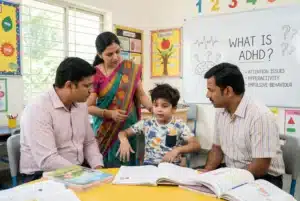
Source: oakandever
By Teaching Letters and Sounds, children can develop adept reading and writing skills. Familiarizing children with letters and their associated sounds, using innovative and engaging approaches, can make the learning process interesting and effective. Employing activities like songs, tales, and sensory tools ensures that children not only recognize letters but also associate them with the correct sound.
Teaching Letters and Sounds together helps in better retention and understanding, laying a strong foundation for early literacy. By incorporating practices like repetition, blending, and storytelling, educators and parents can make this journey both interactive and impactful.
What is the Order of Teaching Letters and Sounds?
An essential step in developing a child’s reading and writing skills is Teaching Letters and Sounds. A methodical and well-thought-out order can make learning fun, effective, and less burdening. The Order of Teaching Letters and Sounds should be strategic, concentrating on the child’s capability to identify and use the letters in everyday language.
Below is a detailed breakdown of the recommended Order of Teaching Letters and Sounds:
Start with High-Frequency Letters
- Begin with letters that appear frequently in simple, commonly used words. Letters like a, t, s, n, p, and i should be introduced first because they form the foundation of many short, phonetic words that children will encounter.
- For example, these letters can quickly combine to form words like sat, nap, and pin, which helps children see practical applications of what they’re learning.
Focus on Lowercase Letters First
- Lowercase letters dominate the written text, making them a priority for young learners. Teaching lowercase letters first ensures that children can identify and write the most commonly used forms of letters.
- Uppercase letters can be introduced later, once the child is comfortable with lowercase forms.
Teach Short Vowel Sounds before Long Vowels
Short vowel sounds are easier to understand and are the building blocks for simple, easy words.
For instance:
- Short vowel sounds such as- a (as in fat), e (as in red), i (as in pin), etc.
- After developing a robust grasp of short vowel sounds, familiarize children with Long vowel sounds (e.g., a- as in make).
Separate Visually or Phonetically Similar Letters
To avoid confusion, do not teach letters with similar shapes or sounds together.
For example:
- Avoid teaching b and d at the same time, as they are visually similar.
- Teach letters like m and n separately to ensure clear differentiation of sounds.
Prioritize High-Utility Letters
High-utility letters, such as e, r, s, t, etc. are essential for forming many basic words. Teaching these early on helps children quickly progress to blending and reading simple words and sentences.
Introduce Letters Based on Complexity
- Use a gradual approach based on the physical and cognitive difficulty of writing and recognizing the letters:
- Straight-line letters first: Start with letters like l, t, i, etc. that have simple straight-line shapes.
- Curved letters next: Move on to letters like c, o, u, etc. that involve curves.
- More complex letters later: Letters with multiple strokes, like k, q, z, etc. should come last.
Supporting Strategies for Teaching Letters and Sounds
To enhance the Teaching Letters and Sounds process, consider incorporating these strategies into your lessons:
Use Consistent Fonts
Use the same font across all teaching materials to avoid confusing children with different styles of letters.
Incorporate Literature and Stories
Introduce letters and sounds through engaging stories and books. For example, you could read a story about a cat while emphasizing the /c/ sound.
Provide Visual Aids
Put up colorful diagrams, flashcards, and posters in the classroom to help children visually relate letters with sounds and things.
Involve in Hands-On Activities
Use tactile means like play dough, magnetic letters, sand trays, etc. to help children shape and explore letters physically.
Encourage Paired Reading
Pair children for reading activities to help them practice letters and sounds in a collaborative and supportive way.
By following this structured Order of Teaching Letters and Sounds and implementing engaging multisensory techniques, you can ensure that children build a strong foundation in literacy. By making recognition of letters and sounds easy, this methodical approach sets the stage for fluent reading and confident writing.

Source: happylittledoers
What is the Importance of Teaching Phonics Letters and Sounds?
Teaching Letters and Sounds is an essential feature of early childhood education. It lays the foundation for academic success and lifelong fondness for learning by providing children with robust comprehension skills.
Here are the key reasons stating the Importance of Teaching Phonics Letters and Sounds:
Reading Skills
Phonics facilitates interpreting words by breaking them into discrete sounds and correlating these sounds with their respective letters. With this technique, reading becomes easy and less intimidating for beginners.
Writing Development
Identifying letters and their sounds is the foremost step toward spelling and writing words. As children understand the connection between letters and sounds, they begin to form words without any guidance.
Vocabulary Development
Reading familiarizes children with new words, thus developing their vocabulary. This, in turn, expands their comprehension skills, entitling them to express themselves more effectively.
Brain Development
Learning phonics stimulates young brains. It improves cognitive functions like memory, attention, and processing speed, leading to overall brain development.
Academic Success
A strong grasp of phonics helps children understand the language of instruction in school. This foundational skill boosts their confidence and performance in various subjects.
Engaging Learning Experience
Phonics lessons can be made entertaining and interactive through songs, games, and narratives. This strategy keeps children motivated and energized to learn.
Vidhyanidhi Education Society offers a Phonics Course that equips teachers with the knacks and techniques for Teaching Letters and Sounds effectively. This Phonics Course emphasizes hands-on learning and creative ways to make phonics entertaining for young learners.
With phonics, parents and educators can help children develop vital literacy skills, paving the way for their prospective academic and personal success.
Make Teaching Letters and Sounds effective! Join Vidhyanidhi Education Society’s Phonics Course!
For more details of Phonics Course Call / Whatsapp +919869866277/+919869546913
To Download Brochure of Phonics Course, Click Here!
Phonics Course
FAQs
Which Letter Sounds to Teach First?
Start with easy, high-frequency sounds like s, a, t, p, i, n to form basic words, followed by vowels and commonly used consonants.
What is the Duration of a Phonics Course?
The duration of a Phonics Course generally covers 6 days, familiarizing crucial strategies for Teaching Phonics efficaciously to young learners.
What is Teaching Letter Sounds Called?
Teaching letter sounds is called phonics, an approach that develops reading and writing skills in children by connecting letters to sounds.



